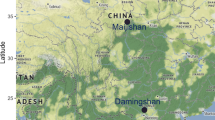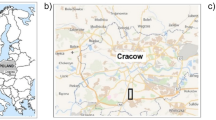Abstract
Acacia nilotica var. tomentosa trees from the Diarra protected forest located in the Senegal River valley were identified for the assessment of both biological nitrogen fixation, using the natural abundance method, and soil bio-functioning parameters (nodulation, root biomass, total microbial biomass, and potential N mineralization). The presence and the genetic diversity of indigenous rhizobia nodulating A. nilotica var. tomentosa was also investigated, taking into account distance from the trunk (0, 1, 2, and 3 m) and depth (0–25, 25–50, and 50–75 cm). Surprisingly, no nodules on the trees root systems were found, whereas under laboratory conditions the presence of indigenous rhizobia nodulating A. nilotica var. tomentosa was demonstrated in the analyzed soils (90% of the nodules harvested on the trapped plants were occupied by the same Inter-Genic Spacer (IGS) group, IGS1). There was no significant influence of trees and/or depth on total microbial biomass and potentials of nitrogen mineralization. Some assumptions were formulated on the possible combined effect of flooding, which usually occurs annually during 4–7 months, and the clayey soils in the Diara forests. Although a deeply natural nodulation of A. nilotica var. tomentosa trees by indigenous rhizobia is not excluded, but it still remains to be demonstrated.


Similar content being viewed by others
References
Amarger N, Mariotti A, Mariotti F (1977) Essai d’estimation du taux d’azote fixe symbiotiquement chez le lupin par le tracage isotopique naturel (15N). C R Acad Sci Serie D 284:2179–2182
Amato M, Ladd JN (1988) Assay for microbial biomass based on ninhydrin-reactive nitrogen in extracts of fumigated soils. Soil Biol Biochem 20:107–114
Arbonnier M (2002) Arbres, arbustes et lianes des zones seches d’Afrique de l’Ouest. CIRAD – MNHN, Montpellier – Paris, 573 pp
Bardin R, Domenach AM, Chalamet A (1977) Rapports isotopiques naturel de l’azote II. Application a la mesure de la fixation symbiotique de l’azote in situ. Rev Ecol Biol Sol 14:395–402
Bremner JM (1965) Inorganic forms of nitrogen. In: Black CA et al (eds) Methods of soil analysis, part 2. Agronomy Monograph 9, ASA, SSSA, Madison, USA, pp 1179–1237
Brewbaker JL (1990) Nitrogen-fixing trees. In: Werner D, Muller P (eds) Fast-growing trees and nitrogen-fixing trees. Gustav Fischer Verlag, Stuttgart, Germany, pp 253–262
Brockwell J, Gault RR, Peoples MB, Turner GL, Lilley DM, Bergensen FJ (1995) N2 fixation in irrigated Lucerne growth for hay. Soil Biol Biochem 27:589–594
Brockwell J, Searle SD, Jeavons AC, Waayers M (2005) Nitrogen fixation in Acacias: an untapped resource for sustainable plantations, farm forestry and land reclamation. ACIAR Monograph No 115, 132 pp
Diouf D, Neyra M, Grouzis M (2003) Phenologie de la nodulation d’Acacia raddiana en milieu naturel. In: Grouzis M, Le Floch E (eds) Un arbre au desert, Acacia raddiana. IRD Editions, Paris, France, pp 171–182
Dommergues YR (1995) Nitrogen fixation by trees in relation to soil economy. Fertil Res 42:215–230
Dommergues YR, Duhoux E, Diem HG (1999) Les arbres fixateurs d’azote: caractéristiques fondamentales et rôle dans l’aménagement des écosystèmes méditerranéens et tropicaux. CIRAD, Editions Espaces, FAO, IRD, Montpellier, Rome, Paris, France, Italy, 500 pp
Dommergues YR, Subba Rao NS (2000) Introduction of N2-fixing trees in Non-N2-fixing tropical plantations. In: Dommergues YR, Subba R (eds) Microbial interactions in agriculture and forestry. Science Publishers Inc, Enfield, Plymouth, USA, UK, pp 131–154
Doran JC, Turnbull JW (1997) Australian trees and shrubs: species for land rehabilitation and farm planting in the tropics. ACIAR Monograph No 24, Camberra, Australia, 384 pp
Dreyfus BL, Dommergues YR (1981) Nodulation of Acacia species by fast and slow growing tropical strains of Rhizobium. Appl Environ Microbiol 41:97–99
Dupuy N, Dreyfus B (1992) Bradyrhizobium populations occur in deep soil under the leguminous tree Acacia albida. Appl Environ Microbiol 58:2415–2419
f J, Plenchette C, Faye A, Peltier R, Lesueur D (2007) Symbiotic status of two protected forests of Acacia nilotica var. tomentosa in the Senegal River Valley. Manuscript submitted for publication in J Arid Environ
Gibson AH (1980) Methods for legumes in glasshouses and controlled environment cabinets. In: Bergersen FJ (ed) Methods for evaluating biological nitrogen fixation. Wiley-Interscience, Chichester, UK, pp 139–184
Grego S, Moscatelli MS, Marinari S, Cacciari I (2003) Activite Biochimique de la rhizosphere d’Acacia raddiana au nord et au sud du Sahara. In: Grouzis M, Le Floch E (eds) Un arbre au desert, Acacia raddiana. IRD Editions, Paris, France, pp 231–247
Marion C, Sall S, Chotte JL, Lesueur D (2004) Soil microbial functioning affected by rhizobial inoculation and gum-arabic production in mature Acacia senegal plantation. In: Proceedings of the 11th Conference of the African Association on Biological Nitrogen Fixation, Dakar, 22–27 November 2004, pp 51
Marschner H (1995) Mineral nutrition of higher plants. Academic Press Limited, San Diego, USA
Navarro E, Simonet P, Normand P, Bardin R (1992) Characterization of natural populations of nitrobacter spp. using PCR/RFLP analysis of the ribosomal intergenic spacer. Arch Microbiol 157:107–115
Njiti CF, Galiana A (1996) Symbiotic properties and Rhizobium requirements for effective nodulation of five tropical dry zone acacias. Agroforestry Syst 34:265–275
Ponsonnet C, Nesme X (1994) Identification of Agrobacterium strains by PCR-RFLP analysis of pTi and chromosomal region. Arch Microbiol 16:300–309
Puri S, Singh S, Kumar S (1994) Growth and productivity of crops in association with an Acacia nilotica tree belt. J Arid Environ 27:37–48
Rouvier C, Prin Y, Reddel P, Normand P, Simonet P (1996) Genetic diversity among Frankia strains nodulating members of the family Casuarinaceae in Australia revealed by PCR and RFLP analysis with crushed root nodules. Appl Environ Microbiol 62:979–985
Sarr A, Neyra M, Oihabi A, Houeibib MA, Ndoye I, Lesueur D (2005a) Characterization of native rhizobial populations presents in soils from natural forests of Acacia senegal and Acacia nilotica in Trarza and Gorgol regions from Mauritania. Microb Ecol 50:152–162
Sarr A, Diop B, Peltier R, Neyra M, Lesueur D (2005b) Effect of rhizobial inoculation methodologies and host plant provenances on nodulation and growth of Acacia senegal and Acacia nilotica. New Forests 29:75–87
Sarr A, Lesueur D (2007) Influence of soil fertility on the rhizobial competitiveness for nodulation of Acacia senegal and Acacia nilotica provenances in nursery and field conditions. World J Microbiol Biot (in press)
Acknowledgments
Full support of this research by the Forest Department of CIRAD, IRD and Project Biodiversity funded by UNDP is gratefully acknowledged. The authors are grateful to I.S. Thioune and I. Fall of the DEFCCS for their technical assistance in the field. The authors wish to thank Dr. Kristina Roing from the Swedish University of Agricultural Sciences (SLU at Uppsala) for reviewing the manuscript and editing the English.
Author information
Authors and Affiliations
Corresponding author
Rights and permissions
About this article
Cite this article
Faye, A., Sall, S., Chotte, JL. et al. Soil bio-functioning under Acacia nilotica var. tomentosa protected forest along the Senegal River. Nutr Cycl Agroecosyst 79, 35–44 (2007). https://doi.org/10.1007/s10705-007-9093-7
Received:
Accepted:
Published:
Issue Date:
DOI: https://doi.org/10.1007/s10705-007-9093-7




